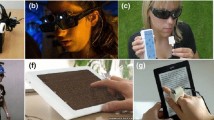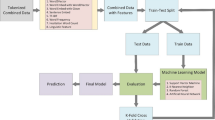Abstract
Background
Hearing aid technology has proven to be successful in the rehabilitation of hearing loss, but its performance is still limited in difficult everyday conditions characterized by noise and reverberation.
Objective
Introduction to the current state of hearing aid technology and presentation of the current state of research and future developments.
Methods
The current literature was analyzed and several specific new developments are presented.
Results
Both objective and subjective data from empirical studies show the limitations of the current technology. Examples of current research show the potential of machine learning-based algorithms and multimodal signal processing for improving speech processing and perception, of using virtual reality for improving hearing device fitting and of mobile health technology for improving hearing health services.
Conclusion
Hearing device technology will remain a key factor in the rehabilitation of hearing impairments. New technology, such as machine learning and multimodal signal processing, virtual reality and mobile health technology, will improve speech enhancement, individual fitting and communication training, thus providing better support for all hearing-impaired patients, including older patients with disabilities or declining cognitive skills.
Zusammenfassung
Hintergrund
Die Hörgerätetechnologie hat sich bei der Rehabilitation von Hörverlusten als erfolgreich erwiesen, aber ihre Leistung ist unter schwierigen Alltagsbedingungen, die durch Lärm und Nachhall gekennzeichnet sind, immer noch begrenzt.
Zielsetzung
Einführung in den aktuellen Stand der Hörgerätetechnologie und Darstellung des aktuellen Forschungsstandes und der zukünftigen Entwicklung.
Methoden
Die aktuelle Literatur wird analysiert und mehrere spezifische Neuentwicklungen werden vorgestellt.
Ergebnisse
Sowohl objektive als auch subjektive Daten aus empirischen Studien zeigen die Grenzen der derzeitigen Technologie auf. Beispiele aus der aktuellen Forschung belegen das Potenzial von auf maschinellem Lernen basierenden Algorithmen und multimodaler Signalverarbeitung zur Verbesserung der Sprachverarbeitung und -wahrnehmung, der Nutzung von virtueller Realität zur Verbesserung der Hörgeräteanpassung und von mobiler Gesundheitstechnologie zur Verbesserung der Hörgesundheitsdienste.
Schlussfolgerung
Die Hörgerätetechnologie wird ein Schlüsselfaktor bei der Rehabilitation von Hörschäden bleiben. Neue Technologien wie maschinelles Lernen und multimodale Signalverarbeitung, virtuelle Realität und mobile Gesundheitstechnologien werden die Sprachverbesserung, die individuelle Anpassung und das Kommunikationstraining verbessern.



Similar content being viewed by others
References
Fan K, Zhao Y (2022) Mobile health technology: a novel tool in chronic disease management. Intell Med 2(1):41–47
Slaney M, Lyon RF, Garcia R, Kemler B, Gnegy C, Wilson K, Cerf VG et al (2020) Auditory measures for the next billion users. Ear Hear 41:131S–139S
Frisby C, Eikelboom R, Mahomed-Asmail F, Kuper H, Swanepoel DW (2022) m‑health applications for hearing loss: a scoping review. Telemed J E Health 28(8):1090–1099
Picou EM (2020) MarkeTrak 10 (MT10) survey results demonstrate high satisfaction with and benefits from hearing aids. Semin Hear 41(1):21–36
Dillon H (2012) Hearing aids. Thieme, Stuttgart
Kayser H, Herzke T, Maanen P, Zimmermann M, Grimm G, Hohmann V (2022) Open community platform for hearing aid algorithm research: open Master Hearing Aid (openMHA). SoftwareX 17:100953
Pavlovic C, Kassayan R, Prakash SR, Kayser H, Hohmann V, Atamaniuk A (2019) A high-fidelity multi-channel portable platform for development of novel algorithms for assistive listening wearables. J Acoust Soc Am 146(4):2878–2878
Wu YH, Stangl E, Chipara O, Hasan SS, DeVries S, Oleson J (2019) Efficacy and effectiveness of advanced hearing aid directional and noise reduction technologies for older adults with mild to moderate hearing loss. Ear Hear 40(4):805
Hendrikse MM, Grimm G, Hohmann V (2020) Evaluation of the influence of head movement on hearing aid algorithm performance using acoustic simulations. Trends Hear 24:2331216520916682
McCormack A, Fortnum H (2013) Why do people fitted with hearing aids not wear them? Int J Audiol 52(5):360–368
Fontan L, Le Coz M, Azzopardi C, Stone MA, Füllgrabe C (2020) Improving hearing-aid gains based on automatic speech recognition. J Acoust Soc Am 148(3):EL227–EL233
Oetting D, Bach JH, Krueger M, Vormann M, Schulte M, Meis M (2019) Subjective loudness ratings of vehicle noise with the hearing aid fitting methods NAL-NL2 and trueLOUDNESS. Proc Int Symp Auditory Audiol Res 7:289–296
Gomez R, Ferguson M (2020) Improving self-efficacy for hearing aid self-management: the early delivery of a multimedia-based education programme in first-time hearing aid users. Int J Audiol 59(4):272–281
Gogate M, Dashtipour K, Adeel A, Hussain A (2020) CochleaNet: A robust language-independent audio-visual model for real-time speech enhancement. Inf Fusion 63:273–285
Tammen M, Doclo S (2022) Deep Multi-Frame MVDR Filtering for Binaural Noise Reduction. arXiv. https://doi.org/10.48550/arXiv.2205.08983 (arXiv:2205.08983)
Nustede EJ, Anemüller J (2021) Towards speech enhancement using a variational U‑Net architecture. In: 29th European Signal Processing Conference (EUSIPCO). IEEE, pp 481–485
Grimm G, Kayser H, Hendrikse M, Hohmann V (2018) A gaze-based attention model for spatially-aware hearing aids. In: Speech Communication; 13th ITG-Symposium. VDE, pp 1–5
Dasenbrock S, Blum S, Debener S, Hohmann V, Kayser H (2021) A step towards neuro-steered hearing aids: Integrated portable setup for time-synchronized acoustic stimuli presentation and EEG recording. Curr Dir Biomed Eng 7(2):855–858
Dasenbrock S, Blum S, Maanen P, Debener S, Hohmann V, Kayser H (2022) Synchronization of ear-EEG and audio streams in a portable research hearing device. Front Neurosci 16. https://doi.org/10.3389/fnins.2022.904003
Hohmann V, Paluch R, Krueger M, Meis M, Grimm G (2020) The virtual reality lab: realization and application of virtual sound environments. Ear Hear 41(Suppl 1):31S
Mehra R, Brimijoin O, Robinson P, Lunner T (2020) Potential of augmented reality platforms to improve individual hearing aids and to support more ecologically valid research. Ear Hear 41(Suppl 1):140S
Grimm G, Luberadzka J, Hohmann V (2019) A toolbox for rendering virtual acoustic environments in the context of audiology. Acta Acust United Acust 105(3):566–578. https://doi.org/10.3813/AAA.919337
Eastgate R, Picinali L, Patel H, D’Cruz M (2016) 3D games for tuning and learning about hearing aids. Hear J 69(4):30–32
Appel L, Appel E, Bogler O, Wiseman M, Cohen L, Ein N, Campos JL et al (2020) Older adults with cognitive and/or physical impairments can benefit from immersive virtual reality experiences: a feasibility study. Front Med 6:329
Steadman MA, Kim C, Lestang JH, Goodman DF, Picinali L (2019) Short-term effects of sound localization training in virtual reality. Sci Rep 9(1):1–17
Rennies J (2023) Better hearing for all: smart solutions for the clinical, subclinical, and normal-hearing population. In: Techniques of Hearing. Routledge, London, pp 77–89
Blustein J, Weinstein BE, Chodosh J (2022) Over-the-counter hearing aids: what will it mean for older americans? J Am Geriatr Soc. https://doi.org/10.1111/jgs.17781
Edwards B (2020) Emerging technologies, market segments, and MarkeTrak 10 insights in hearing health technology. Semin Hear 41(01):37–54
Ross F (2020) Hearing aid accompanying smartphone apps in hearing healthcare. A systematic review. Appl Med Inform 42(4):189–199
Rahme M, Folkeard P, Scollie S (2021) Evaluating the accuracy of step tracking and fall detection in the Starkey Livio artificial intelligence hearing aids: A pilot study. Am J Audiol 30(1):182–189
Acknowledgements
Many thanks to G. Grimm, H. Kayser and all other members of the Auditory Signal Processing group at Oldenburg University.
Funding
Funded by the Deutsche Forschungsgemeinschaft (DFG, German Research Foundation)—Project-ID 352015383 – SFB 1330 – project B1.
Author information
Authors and Affiliations
Corresponding author
Ethics declarations
Conflict of interest
V. Hohmann declares that he has no competing interests.
For this article no studies with human participants or animals were performed by any of the authors. All studies mentioned were in accordance with the ethical standards indicated in each case.
Additional information

Scan QR code & read article online
Rights and permissions
About this article
Cite this article
Hohmann, V. The future of hearing aid technology. Z Gerontol Geriat 56, 283–289 (2023). https://doi.org/10.1007/s00391-023-02179-y
Received:
Accepted:
Published:
Issue Date:
DOI: https://doi.org/10.1007/s00391-023-02179-y




